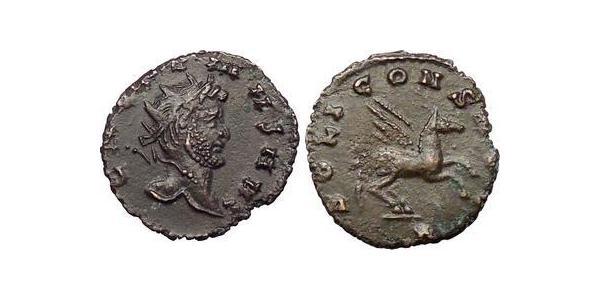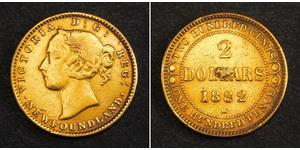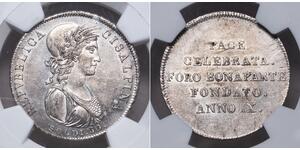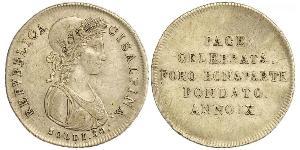[ 3442] Gallienus - Roman Emperor: 253-268 A.D. - Bronze Antoninianus (18mm, 2.54 gm.) Rome 254-255 A.D. Reference: Göbl 712b; RIC 283; Sear 2992. GALLIENVS AVG, radiate and right. Pegasus right springing Heavenward. Provided with certificate of authenticity. CERTIFIED AUTHENTIC by Sergey Nechayev, PhD - Numismatic Expert Bellerophon riding Pegasus (1914) Pegasus (Ancient Greek: Πήγασος, Pégasos, Latin Pegasus) is one of the best known mythological creatures in Greek mythology. He is a winged divine horse, usually depicted as white in colour. He was sired by Poseidon, in his role as horse-god, and foaled by the Gorgon Medusa. He was the brother of Chrysaor, born at a single birthing when his mother was decapitated by Perseus. Greco-Roman poets write about his ascent to heaven after his birth and his obeisance to Zeus, king of the gods, who instructed him to bring lightning and thunder from Olympus. Friend of the Muses, Pegasus is the creator of Hippocrene, the fountain on Mt. Helicon. He was captured by the Greek hero Bellerophon near the fountain Peirene with the help of Athena and Poseidon. Pegasus allows the hero to ride him to defeat a monster, the Chimera, before realizing many other exploits. His rider, however, falls off his back trying to reach Mount Olympus. Zeus transformed him into the constellation Pegasus and placed him up in the sky. Hypotheses have been proposed regarding its relationship with the Muses, the gods Athena, Poseidon, Zeus, Apollo, and the hero Perseus. The symbolism of Pegasus varies with time. Symbol of wisdom and especially of fame from the Middle Ages until the Renaissance, he became one symbol of the poetry and the creator of sources in which the poets come to draw inspiration, particularly in the 19th century. Pegasus is the subject of a very rich iconography, especially through the ancient Greek pottery and paintings and sculptures of the Renaissance. Personification of the water, solar myth, or shaman mount, Carl Jung and his followers have seen in Pegasus a profound symbolic esoteric in relation to the spiritual energy that allows to access to the realm of the gods on Mount Olympus. In the 20th and 21st century, he appeared in movies, in fantasy, in video games and in role play, where by extension, the term "pegasus" (plural: "pegasi is often used to refer to any winged horse. Etymology Ian Hornak, Pegasus, Acrylic on Canvas, National Hellenic Museum, 1991 The poet Hesiod connects the name Pegasus with the word for "spring, well", pēgē: "the pegai of Okeanos, where he was born." A proposed etymology of the name is Luwian pihassas, meaning "lightning", and Pihassassi, a local Luwian-Hittite name in southern Cilicia of a weather god represented with thunder and lightning. The proponents of this etymology adduce Pegasus' role, reported as early as Hesiod, as bringer of thunderbolts to Zeus. Fox (2009) criticizes this suggestion, saying that the connection of Pegasus with lightning bolts may be secondary, based on the "like-sounding name" of the Luwian god. Pegasus and springs Pegasus, as the horse of Muses, was put on the roof of Poznań Opera House ( Max Littmann, 1910) According to legend, everywhere the winged horse struck his hoof to the earth, an inspiring spring burst forth. One of these springs was upon the Muses' Mount Helicon, the Hippocrene ("horse spring"), opened, Antoninus Liberalis suggested, at the behest of Poseidon to prevent the mountain swelling with rapture at the song of the Muses; another was at Troezen. Hesiod relates how Pegasus was peacefully drinking from a spring when the hero Bellerophon captured him. Hesiod also says Pegasus carried thunderbolts for Zeus. Birth There are several versions of the birth of the winged stallion and his brother Chrysaor in the far distant place at the edge of Earth, Hesiod's "springs of Oceanus, which encircles the inhabited earth, where ...
type to read more

|
Posted by:
anonymous 2015-08-19 |
Similar Coin Groups
2025-05-24
- New coin is added to 2 Dollar Canada Gold Victoria (1819 - 1901)
2 Dollar Canada Gold Victoria (1819 - 1901)
group has 39 coins / 38 prices
⇑
1888, Canada, Newfoundland, Queen Victoria. Gold 2 Dollars Coin. Ex-Jewellery! Mint Year: 1882 Reference: KM-5. Denomination: Gold 2 Dollars (200 Cents = 100 Pence) Condition: Welding/tool ...
2025-05-24
- New coin is added to 30 Soldo Italy
30 Soldo Italy
group has 14 coins / 13 prices
⇑
Italien-Cisalpine Republik30 Soldi 1801. Auf den Frieden zu Luneville. Pagani 9. Min. justiert, fast vorzüglich
You may be interested in ...























